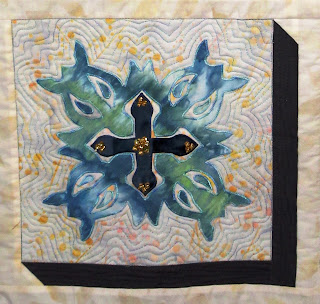It's always exciting to start a new piece of improv work. I love not knowing where the journey will take me, but setting limits keeps the work in check. I make decisions along the way and ask myself questions like what should go next. Do I want a curve? Does this side need a different color? I spend only seconds to a couple minutes on the decision making and move on. One of my problems in the past with template or reproduced patterned quilts is that I get bored with the process after deciding on which fabrics to use. Rotary cutting hundreds of triangles or strips is just tedious for me.
I find it liberating and relaxing to use a pair of scissors to cut and use chalk to mark a curve.
One thing I don't do, is think ahead and plan or have a predetermined idea of what it "should" look like. I also don't want it to look exactly like anything as that would be art quilting. If I wanted to represent a tall skyscraper, it would be drawn out on paper to use as a pattern and pieces would be cut from the pattern. I call it quilt by number, like paint by number. Improv can look like something, but it's unintentional and individual as the brain is trying to interpret it into something known.
This one started as strip sets pulled from my scrap bag, sewn into 4 sheets in differing widths. Then, I added an element by cutting the sheets into curved seed shapes. I added bias strips to the edges of the seed shapes and put them on my design board. I needed to add a background, but didn't want a solid piece of fabric, I had some large triangular shaped solids in my scrap bag and placed them behind my seed shapes.
At the time I didn't like the bright blue or the orange, but I loved the lime green. I also turned the shapes and added some cut pieces to each edge to add some interest. It's not perfect, not measured, but the eye and the brain thinks it's close enough and becomes pleasing. These are the answers you want to be left with. Here is the finished quilt.
When you make a mistake on a quilt made from a pattern, it is painfully obvious. If you make a mistake on an improv or art quilt, its interpreted as intentional. Most times only you will know of a mistake. The question then becomes, can I live with it? My one second answer is YES. Have a sew-full day!


















































.jpg)

.jpg)
